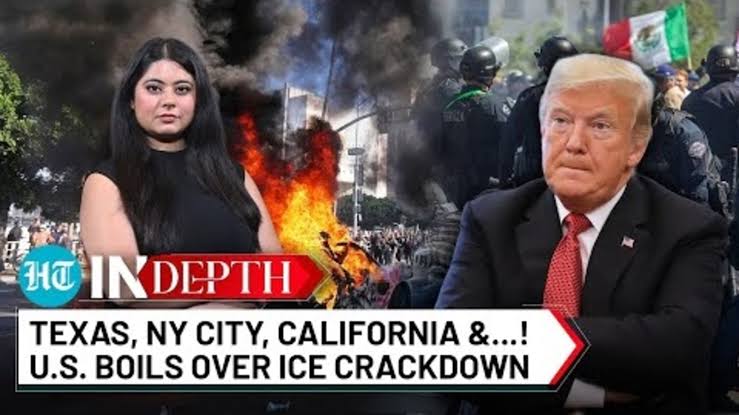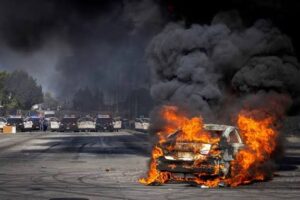Explosive Backlash: Overnight Anti‑ICE Riots Expose Deep Divides

Anti-Ice protesters clashed with officials in Los Angeles as tension increased. Today we will discuss about Explosive Backlash: Overnight Anti‑ICE Riots Expose Deep Divides
Explosive Backlash: Overnight Anti‑ICE Riots Expose Deep Divides
In the early hours of October 3, 2025, a wave of anti-Immigration and Customs Enforcement (ICE) protests erupted across major U.S. cities, igniting a national conversation about immigration enforcement, civil liberties, and political polarization. From Chicago to Portland, demonstrators clashed with federal agents, leading to widespread unrest and raising questions about the future of immigration policy and law enforcement in America.
The Spark: Operation Midway Blitz

The catalyst for these protests was the Trump administration’s launch of “Operation Midway Blitz,” an aggressive immigration enforcement initiative targeting undocumented individuals with criminal records. The operation led to a significant increase in ICE raids, particularly in Democratic-led cities like Chicago, Los Angeles, and Portland. In Chicago, for instance, over 200 protesters gathered outside the Broadview Processing Center, resulting in confrontations with federal agents who deployed tear gas and pepper balls to disperse the crowd .
Escalation in Portland
Portland became a focal point of the unrest. Protests intensified after President Trump ordered the deployment of 200 National Guard troops to the city to protect federal immigration facilities. Local officials, including Mayor Keith Wilson and Governor Tina Kotek, opposed the military intervention, arguing that it was unnecessary given the city’s declining crime rates . Despite this, nightly demonstrations continued, with protesters blocking roads and clashing with federal agents. ICE Director Cammila Wamsley reported that the Portland facility faced ongoing violence for over 100 consecutive nights, with minimal assistance from local police
Chicago’s Confrontation
In Chicago, tensions reached a boiling point when federal agents detained multiple individuals during a protest at the Broadview ICE facility. Demonstrators attempted to block access to the facility, leading to confrontations with law enforcement. Protesters expressed frustration over being restricted to designated zones, arguing that these zones infringed on their First Amendment rights. In response, federal agents deployed tear gas and pepper balls, while state and local law enforcement closed surrounding streets and reinforced security with riot gear and concrete barriers
The National Guard’s Role
The deployment of National Guard troops to Portland and other cities marked a significant escalation in the federal government’s response to the protests. President Trump authorized Defense Secretary Pete Hegseth to use “full force, if necessary,” to quell the unrest. This move drew criticism from local officials and civil rights groups, who argued that the presence of military personnel in civilian areas could exacerbate tensions and infringe upon citizens’ rights to protest .
The Broader Impact
The nationwide protests have highlighted deep divisions within American society regarding immigration policy and the role of law enforcement. Activists argue that the Trump administration’s hardline stance on immigration has led to widespread fear and distrust among immigrant communities. The use of military force to suppress protests has raised concerns about the erosion of civil liberties and the militarization of domestic policing.
In response to the unrest, some local governments have taken steps to limit cooperation with federal immigration authorities. Oregon Attorney General Dan Rayfield filed a lawsuit to block the deployment of federalized National Guard personnel to Portland, arguing that the move violated state sovereignty and the rights of residents .
Looking Ahead
As the situation continues to unfold, the nation faces critical questions about the balance between national security and individual rights, the role of federal versus state authority, and the future of immigration policy. The explosive backlash against ICE and the federal government’s response have underscored the urgency of addressing these issues in a manner that respects both the rule of law and the rights of all citizens.
How useful was this post?
Click on a star to rate it!
Average rating 0 / 5. Vote count: 0
No votes so far! Be the first to rate this post.
About the Author
usa5911.com
Administrator
Hi, I’m Gurdeep Singh, a professional content writer from India with over 3 years of experience in the field. I specialize in covering U.S. politics, delivering timely and engaging content tailored specifically for an American audience. Along with my dedicated team, we track and report on all the latest political trends, news, and in-depth analysis shaping the United States today. Our goal is to provide clear, factual, and compelling content that keeps readers informed and engaged with the ever-changing political landscape.




